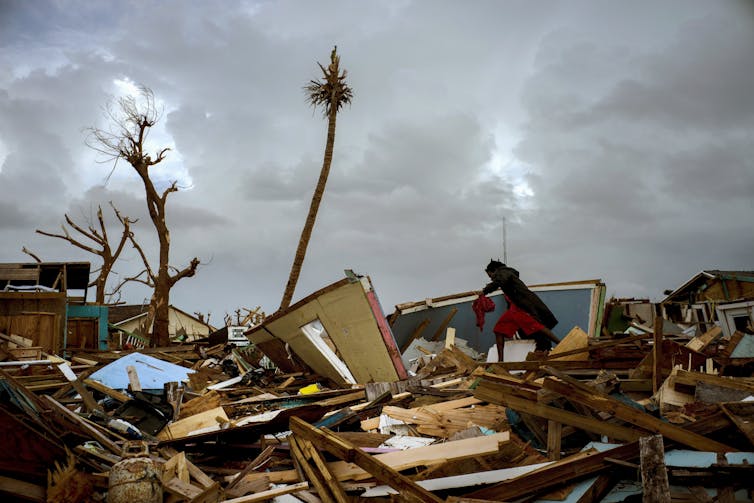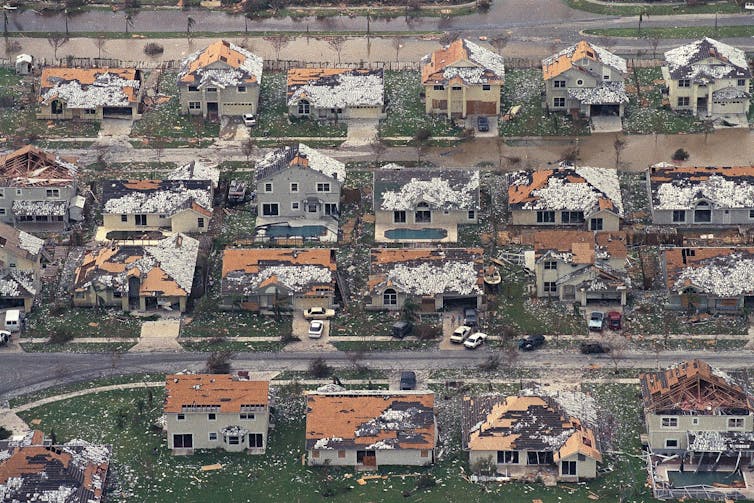
In an airplane hangar in Miami, engineers are recreating some of the most powerful hurricane winds to ever strike land. These Category 5 winds can shatter a test building in the blink of an eye.
Yet they aren’t powerful enough to keep up with nature.
When engineers built the Wall of Wind test facility 10 years ago at Florida International University, it was inspired by Hurricane Andrew, a monster of a storm that devastated South Florida in 1992.
The facility was designed to test structures’ ability to withstand winds up to 160 miles per hour (257 kilometers per hour). Now, we’re seeing the likes of Hurricane Dorian, which shredded neighborhoods in the Bahamas with 184 mph (296 km/h) winds in 2019, and Hurricane Patricia, with winds clocked at 215 mph (346 km/h) off the coast of Mexico in 2015.

Studies show tropical storms are ramping up in intensity as the climate changes and ocean and air temperatures rise. Designing homes and infrastructure to withstand future storms like Dorian will require new test facilities that go well beyond today’s capabilities – for what we believe should be called Category 6 storms.
The Wall of Wind
There is currently only one life-size test facility at a U.S. university capable of generating Category 5 winds, currently the most powerful level of hurricane. That’s the Wall of Wind.
At one end of the facility is a curved wall of 12 giant fans, each as tall as an average person. Working together, they can simulate a 160 mph hurricane. Water jets simulate wind-driven rain. At the other end, the building opens up to a large field where engineers can see how and where structures fail and the debris flies.
The powerful tempests that we create here allow us and other engineers to probe for weaknesses in construction and design, track failures cascading through a building and test innovative solutions in close to real-world storm conditions. Cameras and sensors capture every millisecond as buildings, roofing materials and other items come apart – or, just as important, don’t fail.
Ten years of research here have helped builders and designers reduce the risk of damage. That’s helpful when forecasters warn, as they do for 2022, of a busy hurricane season with several major hurricanes.
Lessons from hurricane testing
We’ve found in destructive testing that a structure will often rip apart in less than a second. All it takes is the wind penetrating the weakest point.
When Hurricane Dorian hit the Bahamas, many less-well-constructed homes turned into shrapnel, creating another problem. Once a building fails, even nearby homes built to withstand higher winds are in trouble because of the flying debris. Our testing has shown how debris from one building, under continuous winds of 130-140 mph or more, can take out the next building, and then that takes out the next building.
Roofs are often that weakest link. A roof is subjected to uplift force during a storm, so wind hitting the surface of the building needs to be able to escape. When wind runs into objects in that path, it can cause damage.
New designs are improving how buildings stand up to extreme winds. For example, storms can create powerful vortices – winds that swirl almost like a corkscrew at a building’s edge – that can strip away roofing material and eventually lift the roof itself. One innovation uses a horizontal wind turbine along the edge of a roof to diffuse the wind and generate power at the same time, a double benefit.

The shape of buildings can also either create weaknesses or help deflect wind. You’ll notice that most modern high-rises avoid sharp corners. Testing shows that more trapezoidal or rounded edges can reduce wind pressures on buildings.
And better safety doesn’t have to be costly. One experiment showed how just US$250 in upgrades was the difference between a small, shed-size building standing up to a Category 3 storm – or not. Hurricane straps attach a roof truss to the perimeter of the house. Ring shank nails, which have threads around the shank to grasp the wood, can resist wind forces better than smooth nails. Hurricane shutters also block entry points where the wind can penetrate and trigger catastrophic failure.
Installation also matters, and helps explain why roofs that appear to meet building code requirements can still fail and go flying in hurricanes.
Experiments we conducted have shown how an edge system – the metal elements between walls and the roof – that is installed just half an inch too high or low can prematurely fail at low winds, even though the system was designed to withstand a Category 5 hurricane. Roofers installing asphalt shingles and roofing tiles may need to go beyond the current code when sealing edges to keep them from failing in a storm.

Expanding testing: 200 mph winds + storm surge
While engineers have been gaining knowledge through testing, the nature of storms is changing as the planet warms.
Warmer temperatures – fueled by increasing greenhouse gas emissions from human activities – enable the air to hold more moisture, and warmer oceans provide more energy to fuel hurricanes. Research shows that bigger and more intense storms that are heavier with water and moving more slowly are going to hammer the areas they hit with more wind, storm surge, flooding and debris.
One study estimated that if Hurricane Ike, which devastated Galveston, Texas, in 2008, were to hit in the warmer climate expected in the late 21st century, its winds would be 13% stronger and it would move 17% slower and be 34% wetter.
Storms like these are why we’re working with eight other universities to design a new facility to test construction against 200 mph winds (322 km/h), with a water basin to test the impact of storm surge up to 20 feet (6 meters) high plus waves.
Computers can model the results, but their models still need to be verified by physical experiments. By combining wind, storm surge, and wave action, we’ll be able to see the entire hurricane and how all those components interact to affect people and the built environment.
Disaster testing is finding ways to make homes safer, but it’s up to homeowners to make sure they know their structures’ weaknesses. After all, for most people, their home is their most valuable asset.
Richard Olson receives funding from the National Science Foundation, the United States Agency for International Development, the Florida Division of Emergency Management, and the Mellon Foundation. He is a member of the Board of Directors of the North American Alliance of Hazards and Disaster Research Institutes.
Ameyu B. Tolera is affiliated with the American Society of Civil Engineers and the American Association for Wind Engineering as a student.
Arindam Chowdhury receives funding from the National Science Foundation, DEM, FSG, and other agencies. He is affiliated with the American Society of Civil Engineers and the American Association for Wind Engineering and other organizations.
Ioannis Zisis receives funding from the National Science Foundation. He is affiliated with the American Society of Civil Engineers and the American Association for Wind Engineering.
This article was originally published on The Conversation. Read the original article.







